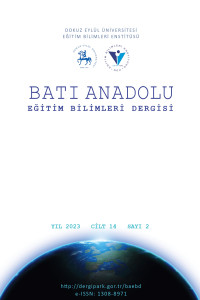Determining the Awareness in the Adaptation Process of Changing Chemical Labeling System: The Views of the Pre-service Science Teachers
Öz
Considering the developments in the field of science education, changes on laboratory safety are among the most important issues. A new regulation on chemicals is being worked on in order to make laboratories in schools safer. The aim is to create a general and universal labeling system in schools, industries, chemical sectors and daily lives for the whole world. The study is aimed to determine the awareness of pre-service science teachers in the adaptation process of changing chemical labeling system. Study conducted by the researcher used semi-structured interview with 6 questions. While preparing the form, the dimensions examined within the scope of the research (introducing chemicals, using glass materials, fire safety, electrical safety, personal protective measures, biological hazards and first aid) were taken into account. The interview was conducted with 10 randomly selected volunteer pre-service science teachers. The data obtained from the records of interviews coded and grouped into categories with using content analysis method. Specific concepts and opinions which are similar to each other are combined and interpreted. Encoding reliabilities (correspondence percentage) was calculated for each item. According to the results most of the pre-service science teachers were able to make corresponding matches in the old and new chemical labeling system, but could not provide sufficient explanations about the regulations that should be included in a typical chemical label, new pictograms and reasons for changing in chemical labeling system.
Anahtar Kelimeler
Chemical Labeling System Pre-Service Science Teachers Laboratory Safety Professional Development
Kaynakça
- BALCI, A. (2005). Sosyal bilimlerde araştırma. Yöntem, Teknik ve İlkeler, Ankara: PegemA Yayınları.
- Çelik, H., Baykal, N. B., & Memur, H. N. K. (2020). Nitel veri analizi ve temel ilkeleri. Eğitimde Nitel Araştırmalar Dergisi, 8(1), 379-406. doi:10.14689/issn.2148-2624.1.8c.1s.16m
- Council of State Science Supervisors [CSSS], (2000). Science & Safety Making the Connection. http://www.csss.enc.org with full text from-ERIC-ED449028
- DeMary, L. (2000). Safety in Science Teaching. Virginia: Commonwealth of Virginia Department of Education Richmond.
- Ministry of National Education (MoNE). (2018). Strengthening Vocational Education and Training System Project (MEGEP), Chemistry Technology Alcohols and Ethers. Ankara: State Books Directorate Publishing House.
- National Fire Protection Association (NFPA), (2004). NFPA 45 Standard on Fire Protection for Laboratories Using Chemicals. Quincy, MA: Author
- National Science Teachers Association (NSTA). (2007). Safety and School Science Instruction. Arlington, VA: NSTA Press.
- Occupational Safety and Health Administration (OSHA), (1997). Small Entity Compliance Guide for OSHA's Abatement Verification Regulation (29 CFR 1903.19). USA: Department of Labor. https://www.osha.gov/
- Roy, K., Markow, P., & Kaufman, J. (2010). Safety is Elementary. 2nd ed. Natick, Massachusetts: The Laboratory Safety Institute Inc.
- Stroud L.M.,Stallings, C. ve Korbusieski, T. J., (2007, May/June). Implementation of a Science Laboratory Safety Program in North Carolina Schools. Journal of Chemical Health and Safety, 20-24.
- Yıldırım, A. & Şimşek, H. (2013). Sosyal bilimlerde nitel araştırma yöntemleri. Ankara: Seçkin.
Değişen Kimyasal Etiketleme Sistemine Uyum Sürecindeki Farkındalığın Belirlenmesi: Fen Bilgisi Öğretmen Adaylarının Görüşleri
Öz
Fen eğitimi alanındaki gelişmelere bakıldığında, laboratuvar güvenliğine ilişkin yapıln değişikliklerin en önemli konular arasında yer aldığı görülmektedir. Son dönemde okullardaki laboratuvarları daha güvenli hale getirmek için kimyasallarla ilgili yeni bir yönetmelik üzerinde çalışılmaktadır. Amaç, tüm dünya için okullarda, endüstrilerde, kimya sektörlerinde ve günlük yaşamda genel ve evrensel bir etiketleme sistemi oluşturmaktır. Çalışma, fen bilgisi öğretmen adaylarının değişen kimyasal etiketleme sistemine uyum sürecindeki farkındalıklarını belirlemeyi amaçlamaktadır. Araştırmacı tarafından yürütülen çalışmada 6 soruluk yarı yapılandırılmış görüşme formu kullanılmıştır. Form hazırlanırken araştırma kapsamında incelenen boyutlar (kimyasalların tanıtılması, cam malzeme kullanımı, yangın güvenliği, elektrik güvenliği, kişisel koruyucu önlemler, biyolojik tehlikeler ve ilk yardım) dikkate alınmıştır. Görüşme, rastgele seçilen 10 gönüllü fen bilgisi öğretmen adayı ile gerçekleştirilmiştir. Görüşme kayıtlarından elde edilen veriler içerik analizi yöntemi kullanılarak kodlanmış ve kategoriler halinde gruplandırılmıştır. Birbirine benzeyen belirli kavramlar ve görüşler birleştirilerek yorumlanmıştır. Her bir madde için kodlama güvenirliği (uyuşma yüzdesi) hesaplanmıştır. Sonuçlara göre, fen bilgisi öğretmen adaylarının çoğu eski ve yeni kimyasal etiketleme sisteminde karşılık gelen eşleştirmeleri yapabilmiş, ancak tipik bir kimyasal etiketinde bulunması gereken düzenlemeler, yeni piktogramlar ve kimyasal etiketleme sistemindeki değişikliğin nedenleri hakkında yeterli açıklama yapamamıştır.
Anahtar Kelimeler
Kimyasal Etiketleme Sistemi Fen Bilgisi Öğretmen Adayları Laboratuvar Güvenliği Mesleki Gelişimi
Kaynakça
- BALCI, A. (2005). Sosyal bilimlerde araştırma. Yöntem, Teknik ve İlkeler, Ankara: PegemA Yayınları.
- Çelik, H., Baykal, N. B., & Memur, H. N. K. (2020). Nitel veri analizi ve temel ilkeleri. Eğitimde Nitel Araştırmalar Dergisi, 8(1), 379-406. doi:10.14689/issn.2148-2624.1.8c.1s.16m
- Council of State Science Supervisors [CSSS], (2000). Science & Safety Making the Connection. http://www.csss.enc.org with full text from-ERIC-ED449028
- DeMary, L. (2000). Safety in Science Teaching. Virginia: Commonwealth of Virginia Department of Education Richmond.
- Ministry of National Education (MoNE). (2018). Strengthening Vocational Education and Training System Project (MEGEP), Chemistry Technology Alcohols and Ethers. Ankara: State Books Directorate Publishing House.
- National Fire Protection Association (NFPA), (2004). NFPA 45 Standard on Fire Protection for Laboratories Using Chemicals. Quincy, MA: Author
- National Science Teachers Association (NSTA). (2007). Safety and School Science Instruction. Arlington, VA: NSTA Press.
- Occupational Safety and Health Administration (OSHA), (1997). Small Entity Compliance Guide for OSHA's Abatement Verification Regulation (29 CFR 1903.19). USA: Department of Labor. https://www.osha.gov/
- Roy, K., Markow, P., & Kaufman, J. (2010). Safety is Elementary. 2nd ed. Natick, Massachusetts: The Laboratory Safety Institute Inc.
- Stroud L.M.,Stallings, C. ve Korbusieski, T. J., (2007, May/June). Implementation of a Science Laboratory Safety Program in North Carolina Schools. Journal of Chemical Health and Safety, 20-24.
- Yıldırım, A. & Şimşek, H. (2013). Sosyal bilimlerde nitel araştırma yöntemleri. Ankara: Seçkin.
Ayrıntılar
| Birincil Dil | İngilizce |
|---|---|
| Konular | Alan Eğitimleri |
| Bölüm | Makaleler |
| Yazarlar | |
| Erken Görünüm Tarihi | 24 Aralık 2023 |
| Yayımlanma Tarihi | 28 Aralık 2023 |
| Gönderilme Tarihi | 26 Nisan 2023 |
| Yayımlandığı Sayı | Yıl 2023 Cilt: 14 Sayı: 2 |


